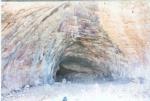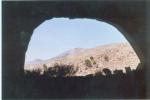Summary (English)
The existence of findings in the Historic-Artistic Museum of Novelda from the Cova dels Calderons, in the municipal district of La Romana, made us see the possibilities in its study, and allowed the drawing of a cave plan. The study of these materials require a certain level of caution since their provenance is due to the exploitation of the cave by an amateur.
The rock shelter is 550m in altitude, west of the village, in a valley between the Sierra del Reclot, Cerro del Reclot and Cerro de la Cruz. It is oriented to the southwest, and its formation comes from Jurassic limestone outcrops that were later modified by the precipitation of calcium carbonate. After the permission of the Culture Department was given, in February 2000 we carried out our first prospection campaign in the zone, followed by drawing in June 2000.
The findings, now in the Museum of Novelda, includes 10 ceramic fragments, 20 perforated snails and 165 lithic pieces. Also in the prospection of the cave we collected some pieces at the site. The ceramic fragments were collected discriminately as the pieces were of a significant size, and decorated with loop starts and edges. Among its technical characteristics is a grainy, hard and compact paste with heterogeneous inclusions where limestone predominates, with reduction firings. Three fragments suggest certain inferences: all sherds have vertical ellipsoid trends, although one of them could be a semiellipsoid. Their decorations are imprinted, incised and combed, normally with smoothed and burnished finishes.
Among the raw materials of this lithic assemblage are grey (37,3%), brown (28,3%) and honey-coloured flint (25,3%) but also pieces in black, red, purple and garnet colour flint. Of 165 pieces, 121 are carved objects, and 45 contemporary flakes. There is a large number of scrapers (50%) highlighting those made in flake or in blade flake, although also appear to flake and snout. They are supplemented by 2 chisels and 2 microburins, 2 scrapers and 3 simples burins. It is interesting to note the presence of adjustments on the blades and folding edge slats representing 20,6 per cent of the pieces. On the whole, the assemblage presents a high level of microlithization with a limit of about 34mm. One of the most interesting facts is the lack of sickle elements as well as the absence of grain shine in the lithic pieces.
All of this data lead us to believe thatthe ‘Cova dels Calderons’ was a prehistoric settlement of the Middle and Late Neolithic period. From a socio-economic point of view, we saw that the materials were not relevant to agricultural production and storage, without distinction of activity areas, with very few imported ítems. This appears to be a system where agricultural components are not essential for survival, but are necessarily complementd with others activities such as hunting and gathering. This site presents a model of sparse population in Vinalopó, where there is only the Neolithic hábitat cave, of the Cueva del Lagrimal. It probably represents the hunter-gatherer sustrate which was impacted by the Neolithic period, already at advanced stages of acculturation and the preservation of ancestral economic practices.
(translation by Esther Casares Carmona)
- José Ramón García Gandía
Director
- José Ramón García Gandía
Team
- Gabriel García Atienzar y Francisco Javier Molina Hernández
- Museo Histórico-Artístico de la Ciudad de Novelda
Research Body
- Colegio Oficial de Doctores y Licenciados en Filosofía y Letras y en Ciencias de Alicante - Sección de Arqueología
Funding Body
- Conselleria de Educación, Cultura y Deporte de la Generalitat Valenciana






![Download [PDF]](/excavation/skins/fasti/images/results/download_sml.png)
